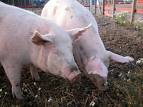by Michel Chossudovsky | |
 Global Research, July 10, 2009 "Pigs at risk from people as new flu spreads" citing authoritative scientific sources is the title of a recent news report. "With the increasing numbers of human infections, a spillover of this virus to pigs is becoming more likely." Pigs are the victims. Humans are the perpetrators. In a twisted logic, the news reports convey the impression that only people can infect pigs with the H1N1 swine flu and that pigs cannot be the original source of the infection.
The German report also suggests that pigs are at risk to contract the virus from humans, and should be vaccinated to avoid the spread of the virus among the pig population:
The report blatantly contradicts itself in claiming that human to pig transmission is the main causal factor:
The report refers to a Canadian hog farm in Alberta where more than 200 animals were infected with the H1N1 virus in a single hog farm. (For further details see Michel Chossudovsky,The A H1N1 Pandemic: Pig to Human Transmission of the Swine Flu? Global Research, May 15, 2009). The incident was covered up. The facts were distorted. Health authorities initially stated that it was a Mexican farm worker who infected the pigs. It was, however, established that human to pig transmission was not the cause. SO WHAT WAS THE CAUSE? More precisely if humans are not the source of infection of the pigs, who is the source of the infection? Where did the virus infection originate? This question was carefully sidestepped both by Canadian health officials and the media. If more than 200 animals are infected with H1N1 virus on a single hog farm, does this not suggest that the virus was endemic to that particular hog farm. The pigs were subsequently culled to "kill the evidence" There are indications that pigs in North American hog farms, as evidenced by the Alberta hog farm, could be infected with the H1N1 strain and that this is not the result of human to pig transmission. | |
Does Europe Fear A Russian Invasion? The Solution is a “Mutual Security
Agreement”
-
*German chancellor Friedrich Merz warns that Russia’s President Putin will
not stop waging war if Ukraine falls, and he is sending German soldiers to
ass...
3 hours ago










